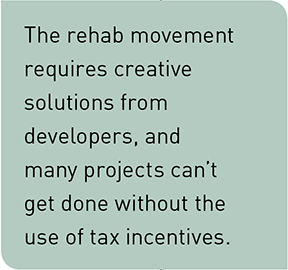HOME | ABOUT US | MEDIA KIT | CONTACT US | INQUIRE
HOME | ABOUT US | MEDIA KIT | CONTACT US | INQUIRE


Over the past 10-15 years, commercial real estate has seen a lot of changes. Rehabilitation, or repurposing, has been a buzzword for many multi-family, retail and office projects.
With the use of tax incentives, including abatement tools, tax-increment financing and historic credits at the federal and state levels, as well as low-income credits, older structures have been repurposed into apartments, lofts and the like. Indeed, in many bigger cities, central business districts and close-by urban areas have been transformed into new residential communities.
Problems that developers incur in multi-family rehabs include securing parking, remediation of environmental issues and re-plumbing and new HVAC systems. These issues can be economically solved by the use of tax incentives. Marketing for these properties is also different than classic residential marketing. Typically, these properties are marketed to young professionals and empty-nesters. These people are typically willing to explore a new type of living arrangement. Young professionals who choose to live in these areas have the added benefit often times of working near the places they live, assuming the apartments or lofts are located Downtown. The lack of primary and secondary schooling in these areas is still an issue, but some jurisdictions are successfully tackling the issue by using TIFs to help finance charter schools and the like.
Another area of real estate where repurposing is going on is with retail malls. The malls in question are often referred to as dead or zombie malls. Dead malls are malls that are quite succinctly dead and closed due to a variety of reasons, including changes in buying habits of consumers (e.g. internet shopping) and the shift of where consumers are choosing to live. Zombie malls are those malls that are hanging on even though big retailers have left the mall or the area close to the mall has changed (e.g. residents have moved out).

When a mall starts down the road of becoming a zombie mall, what happens in the industry? Often, the developer tries to re-tenant without the luxury of a big box retailer. That often proves to be problematic and very expensive. Often, cities and/or residents react negatively towards any big box retailer. Proceeding forward without a replacement big retailer is very expensive and may render the mall non-financeable. Governmental approvals very often are a stumbling block. It is essential to get governmental bodies on board. Developers must convince cities that today’s successful big box retailers are essential in turning around down-trodden malls.
Incentives are also crucial in rehabilitating a mall, just as they are in multi-family and office rehabs. Besides those tools previously mentioned, the creation of a community improvement district may be helpful.
Sometimes, it is simply not possible to rehab a mall in a conventional way. Drive around old mall sites and you will see different uses cropping up within the mall. Often, you will see government offices like a driver’s license bureau in the mall. Branches of hospitals or clinics are often found in these malls. Another adaptive reuse is to locate a church or synagogue within the mall. Such a use may sound strange at first thought, but may fit well as a religious institution seeks to get off the ground.
A final area in commercial real estate where rehabilitation is happening is office. In the last couple years, employment numbers have been getting better. These employment gains are benefitting both offices in the central business districts and the suburbs. As new office leases are being entered into, one change that we are seeing is a complete rethinking of office layout. Typical layouts traditionally in office include individual offices and conference rooms. My law firm is set up that way and has been for some time.
New office space coming on line is throwing older design out and a changing to an open-space configuration. This new configuration is actually not new—big companies have for many years used the “bullpen” approach, with signs hanging over areas to delineate which area of the company is situated within a given floor.
Taking a page out of multi-family rehabbing, developers who reposition their office space as open space will often need tax incentives to make the wholesale changes required in such a conversion.
In summary, rehabilitation or repurposing is often the name of the game in the commercial real estate sectors of multi-family, retail and office. Creative solutions are required by developers and many projects can’t get done without the use of tax incentives.
(The author wishes to acknowledge his partner Stacy Wipfler and an article she recently authored in Commercial Property Executive on Dead Malls, dated August 25, 2015.)